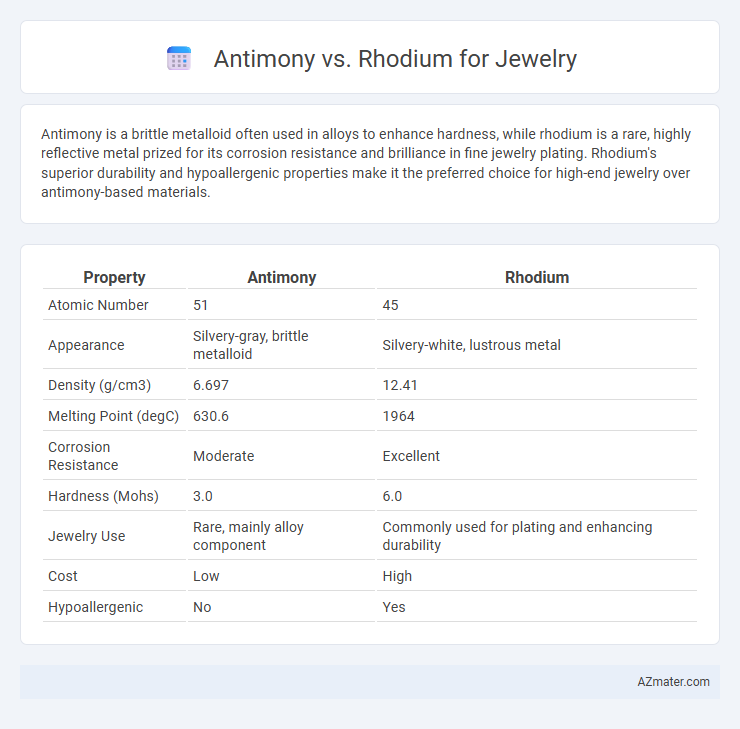Antimony is a brittle metalloid often used in alloys to enhance hardness, while rhodium is a rare, highly reflective metal prized for its corrosion resistance and brilliance in fine jewelry plating. Rhodium's superior durability and hypoallergenic properties make it the preferred choice for high-end jewelry over antimony-based materials.
Table of Comparison
| Property | Antimony | Rhodium |
|---|---|---|
| Atomic Number | 51 | 45 |
| Appearance | Silvery-gray, brittle metalloid | Silvery-white, lustrous metal |
| Density (g/cm3) | 6.697 | 12.41 |
| Melting Point (degC) | 630.6 | 1964 |
| Corrosion Resistance | Moderate | Excellent |
| Hardness (Mohs) | 3.0 | 6.0 |
| Jewelry Use | Rare, mainly alloy component | Commonly used for plating and enhancing durability |
| Cost | Low | High |
| Hypoallergenic | No | Yes |
Introduction: Antimony vs Rhodium in Jewelry
Antimony and rhodium are distinct elements with contrasting uses and properties in jewelry. Rhodium, a rare and valuable platinum-group metal, is commonly used for plating to provide a reflective, tarnish-resistant finish on white gold and silver jewelry. Antimony, in contrast, is a metalloid primarily used as an alloying agent to enhance hardness and durability but is rarely used as a stand-alone material in jewelry fabrication.
Chemical Properties and Composition
Antimony is a metalloid with atomic number 51, known for its brittleness and resistance to oxidation, making it less ideal for direct use in jewelry but valuable as an alloying element to enhance hardness and durability. Rhodium, atomic number 45, is a rare, silver-white transition metal highly valued in jewelry for its exceptional corrosion resistance, high reflectivity, and ability to form a durable, tarnish-resistant plating over metals like gold and silver. The chemical stability of rhodium, combined with its high melting point of 1964degC and inertness, contrasts with antimony's semi-metallic nature and lower melting point of 630.6degC, making rhodium more suitable for fine jewelry applications requiring longevity and luster.
Appearance and Aesthetic Appeal
Antimony in jewelry offers a unique, matte finish with a grayish tone that appeals to those seeking understated elegance, while rhodium is prized for its brilliant, reflective surface and bright white appearance that enhances the shine of precious metals. Rhodium plating is commonly used to provide a durable, tarnish-resistant coating on white gold and silver, elevating the jewelry's overall luster and luxurious feel. The choice between antimony and rhodium significantly impacts the jewelry's aesthetic appeal, balancing subtle sophistication against striking brilliance.
Durability and Wear Resistance
Rhodium exhibits exceptional durability and wear resistance, making it a preferred choice for jewelry plating to enhance scratch resistance and maintain a bright, tarnish-free finish over time. Antimony, while used in alloy form to improve hardness, generally lacks the superior scratch resistance and corrosion resistance that rhodium provides. Jewelry pieces rhodium-plated endure daily wear better, retaining luster longer compared to those alloyed primarily with antimony.
Hypoallergenic Qualities
Antimony, rarely used in jewelry, can cause skin irritation and allergic reactions, making it less suitable for sensitive skin. Rhodium, a precious metal often used as a plating on white gold and silver, is highly valued for its hypoallergenic properties and resistance to tarnish. Jewelry coated with rhodium offers a durable, skin-friendly finish ideal for those with metal allergies.
Cost Comparison and Market Availability
Antimony is significantly more affordable than rhodium, making it a cost-effective option for budget-conscious jewelry designs, while rhodium commands a high price due to its rarity and superior corrosion resistance. Rhodium's market availability is limited, primarily sourced as a by-product of platinum and nickel mining, which restricts supply and drives up costs. In contrast, antimony is more abundantly available globally, ensuring steady supply and consistent pricing for manufacturers.
Common Uses in Jewelry Design
Antimony is rarely used directly in jewelry but often appears as an alloying element to improve the hardness and durability of metals such as lead or tin used in costume jewelry. Rhodium is highly valued in jewelry design for its reflective, white metallic finish and exceptional resistance to tarnish and scratches, making it a popular plating choice for enhancing the appearance and longevity of white gold and platinum pieces. The primary distinction lies in Rhodium's role as a premium, protective coating for fine jewelry, whereas Antimony serves more functional, supportive roles in base metal alloys.
Maintenance and Care Requirements
Antimony alloys in jewelry require minimal maintenance but can tarnish over time, necessitating occasional polishing with a soft cloth and mild cleaner to retain shine. Rhodium-plated jewelry demands regular re-plating every 1 to 2 years to maintain its reflective, tarnish-resistant surface, especially for high-wear pieces like rings and bracelets. Proper storage in a dry, soft-lined box and avoidance of harsh chemicals prolongs the lifespan and appearance of both antimony and rhodium jewelry.
Environmental and Ethical Considerations
Antimony used in jewelry often raises environmental concerns due to toxic mining practices and its potential to contaminate soil and water sources, impacting local ecosystems and communities. Rhodium, typically sourced as a byproduct of platinum and nickel mining, has a more limited direct environmental footprint but involves energy-intensive extraction and refining processes. Ethical considerations for rhodium include ensuring responsible sourcing from conflict-free regions, while antimony's supply chain transparency remains less developed, leading to challenges in certifying ethical standards.
Which Metal Is Best for Your Jewelry?
Rhodium is highly valued in jewelry for its exceptional durability, brilliant white shine, and resistance to tarnish, making it ideal for high-end pieces and plating over white gold or silver to enhance luster and longevity. Antimony, while used in some metal alloys to improve hardness, is not typically employed as a primary material for jewelry due to its brittleness and lower aesthetic appeal. For lasting beauty, hypoallergenic properties, and superior wear resistance, rhodium is the preferred choice over antimony in fine jewelry applications.

Infographic: Antimony vs Rhodium for Jewelry
 azmater.com
azmater.com